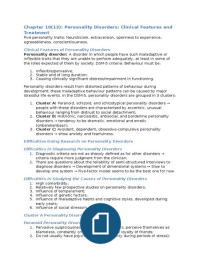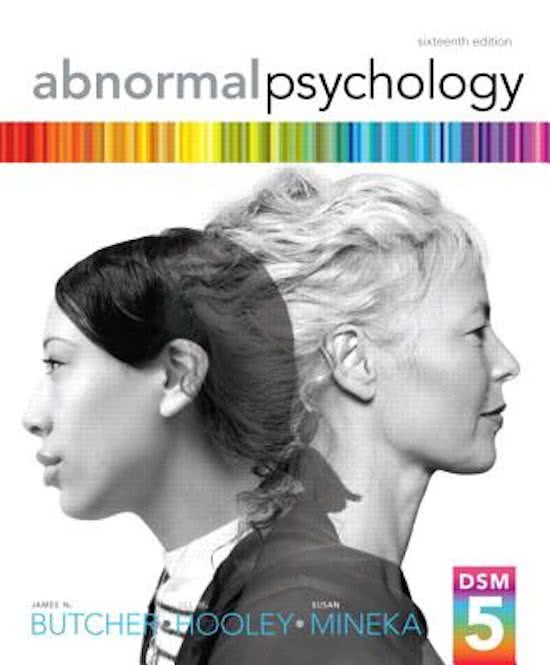Chapter 10(13): Personality Disorders: Clinical Features and
Treatment
Five personality traits: Neuroticism, extraversion, openness to experience,
agreeableness, conscientiousness.
Clinical Features of Personality Disorders
Personality disorder: A disorder in which people have such maladaptive or
inflexible traits that they are unable to perform adequately, at least in some of
the roles expected of them by society. DSM-5 criteria: Behaviour must be:
1. Inflexible/pervasive;
2. Stable and of long duration;
3. Causing clinically significant distress/impairment in functioning.
Personality disorders result from distorted patterns of behaviour during
development; these maladaptive behaviour patterns can be caused by major
stressful life events. In the DSM-5, personality disorders are grouped in 3 clusters:
1. Cluster A: Paranoid, schizoid, and schizotypical personality disorders →
people with these disorders are characterised by eccentric, unusual
behaviour ranging from distrust to social detachment;
2. Cluster B: Histrionic, narcissistic, antisocial, and borderline personality
disorders → tendency to be dramatic, emotional and erratic
(onberekenbaar);
3. Cluster C: Avoidant, dependent, obsessive-compulsive personality
disorders → show anxiety and fearfulness.
Difficulties Doing Research on Personality Disorders
Difficulties in Diagnosing Personality Disorders
1. Diagnostic criteria are not as sharply defined as for other disorders →
criteria require more judgment from the clinician;
2. There are questions about the reliability of semi-structured interviews to
diagnose disorders → Development of dimensional systems ↔ Slow to
develop one system → Five-factor model seems to be the best one for now.
Difficulties in Studying the Causes of Personality Disorders
1. High comorbidity;
2. Relatively few prospective studies on personality disorders;
3. Influence of temperament;
4. Influence of genetic factors;
5. Influence of maladaptive habits and cognitive styles, developed during
early years;
6. Influence of social stressors.
Cluster A Personality Disorders
Paranoid Personality Disorder
1. Pervasive suspiciousness and distrust of others, perceive themselves as
blameless, constantly on guard, doubting the loyalty of friends;
2. Do not usually have psychotic symptoms (only during periods of stress);
, 3. Share some symptoms with people with paranoid schizophrenia; however,
they lack many additional symptoms;
4. Causal factors:
1. No consistent evidence that it is linked to schizophrenia;
2. Genetic factors that seem to be involved include antagonism (low
agreeableness), neuroticism (angry-hostility);
3. Parental neglect, abuse, exposure to violent adults.
Schizoid Personality Disorder
1. Unable to form social relationships and do not have interest in doing so;
2. Lack social skills and are perceived as cold and distant, do not express
feelings;
3. Do not take pleasure in many activities;
4. Show a generally apathetic mood;
5. High levels of introversion, low levels of openness to feelings and
achievement striving;
6. Causal factors:
1. People with SPD are not the ones to volunteer for research → few
research;
2. Genetic link between schizophrenia and SPD is very modest;
3. Schizoid personality traits have some heritability;
4. Cause might be maladaptive underlying schemas → people view
themselves as self-sufficient loners, and others as intrusive;
Schizotypical Personality Disorder
1. People are excessively introverted and have pervasive social and
interpersonal deficits (like in schizoid PD) + have cognitive and perceptual
distortions: oddities and eccentricities in communication and behaviour;
2. Characterized by highly personalized and superstitious thinking, extreme
stress → psychotic symptoms (believe they have magic powers, engage in
rituals). Other problems include ideas of reference (interpreting others
conversations as relevant to oneself), odd speech and paranoid beliefs;
3. The aspects of schizotypy that have to do with cognitive and perceptual
distortions, are not explained by the five-factor model; rather, they seem
to be caused by the factor of psychoticism.
4. Causal factors:
1. Prevalence: 2-3%;
2. Moderate heritability;
3. Many aspects (language, inhibition, distractibility, attention) found in
schizophrenia are also found in schizotypy;
4. It seems to be related to schizophrenia. However, another form of
schizotypy is more linked to childhood abuse and early trauma,
exposure to life events and low SES.
Cluster B Personality Disorders
Histrionic Personality Disorder
1. Excessive attention-seeking and emotionality;
2. Appearance and behaviour are theatrical and sexually provocative,
because these people crave attention → people do not have stable
relationships;





